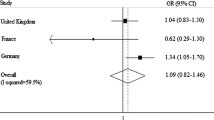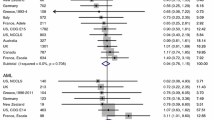We examined the association between parental occupation and childhood cancer among 252 incident cases of childhood cancer (ages 0–14, diagnosed 1976–83) and 222 controls selected by random digit dialing in Denver, Colorado (USA). A job-exposure matrix was used to assign parental exposures based on job titles, emphasizing chemicals that were implicated in previous studies. All cancers, acute lymphocytic leukemia (ALL), and brain cancer were examined in relation to parental occupation during the year prior to the birth of the child. Elevated odds ratios (OR), all with confidence intervals extending below the null, were found for maternal exposure to benzene (OR=1.9), petroleum/coke pitch/tar (OR=2.2), and soot (OR=3.3) in relation to total cancers. The ORs for total cancer and paternal exposure to all hydrocarbons combined was 1.0. Results for individual hydrocarbons and ALL showed larger odds ratios, including aniline (OR=2.1), benzene (OR=1.6), and petroleum/coke pitch/tar (OR=1.6). Potential exposure to creosote was strongly associated with brain cancer (OR=3.7) based on five exposed cases (95 percent confidence interval = 0.8–16.6). Control for other potential childhood cancer risk factors did not alter the results substantially. In spite of uncertainties due to small numbers and errors in exposure classification, results tend to corroborate past research that suggests an association between specific parental occupational exposures and childhood cancer.
Similar content being viewed by others
References
Savitz DA, Chen J. Parental occupation and childhood cancer: review of epidemiologic studies. Environ Health Perspect 1990; 88: 325–37.
O'Leary LM, Hicks AM, Peters JM, London S. Parental occupational exposure and risk of childhood cancer: a review. Am J Ind Med 1991; 20: 17–35.
Fabia J, Thuy TD. Occupation of father at time of birth of children dying of malignant disease. Br J Prev Soc Med 1974: 28: 98–100.
Kantor AF, McCrea-Curnen MG, Meigs JW, Flannery JT. Occupations of fathers of patients with Wilm's tumour. J Epidemiol Community Health 1979; 33: 253–6.
Kwa SI, Fine LJ. The association between parental occupation and childhood malignancy. J Occup Med 1980; 22: 292–4.
Gold GB, Diener BS, Szklo M. Parental occupations and cancer in children. J Occup Med 1982; 24: 578–84.
Vianna NJ, Kovasznay B, Polan A, Ju C. Infant leukemia and paternal exposure to motor vehicle exhaust fumes. J Occup Med 1984; 26: 679–82.
Hicks N, Zack M, Caldwell GG, Fernbach DJ, Falletta JM. Childhood cancer and occupational radiation exposure in parents. Cancer 1984; 53: 1637–43.
Johnson CC, Annegers JF, Frankowski RF, Spitz MR, Buffler PA. Childhood nervous system tumors—an evaluation of the association with paternal occupational exposure to hydrocarbons. Am J Epidemiol 1987; 126: 605–13.
Hemminki K, Saloniemi I, Salonen T, Partanen T, Vainio H. Childhood cancer and parental occupation in Finland. J Epidemiol Community Health 1981; 35: 11–15.
Zack M, Cannon S, Loyd D, et al. Cancer in children of parents exposed to hydrocarbon-related industries and occupations. Am J Epidemiol 1980; 111: 329–36.
Shaw G, Lavey R, Jackson R, Austin D. Association of childhood leukemia with maternal age, birth order and paternal occupation. Am J Epidemiol 1984; 119: 788–95.
Sanders BM, White GC, Draper GJ. Occupations of fathers of children dying from neoplasms. J Epidemiol Community Health 1981; 35: 245–50.
Hakulinen T, Salonen T, Teppo L. Cancer in the off-spring of fathers in hydrocarbon-related occupations. Br J Prev Soc Med 1976; 30: 138–40.
van Steensel-Moll HA, Valkenburg HA, Van Zanen GE. Childhood leukemia and parental occupation. Am J Epidemiol 1985; 121: 216–24.
Shu XO, Tang Y, Brinton LA, et al. A population-based case-control study of childhood leukemia in Shanghai. Cancer 1988; 62: 635–44.
Peters JM, Preston-Martin S, Yu MC. Brain tumors in children and occupational exposure of parents. Science 1981; 213: 235–6.
Lowengart RA, Peters JM, Cicioni C, et al. Childhood leukemia and parents' occupational and home exposures. JNCI 1987; 79: 39–46.
McKinney PA, Alexander FE, Cartwright RA, Parker L. Parental occupations of children with leukaemia in west Cumbria, north Humberside, and Gateshead. Br Med J 1991; 302: 681–7.
Hoar SK, Morrison AS, Cole P, Silverman DT. An occupational and exposure linkage system for the study of occupational carcinogenesis. J Occup Med 1980; 22: 722–6.
Savitz DA, Zuckerman DL. Childhood cancer in the Denver metropolitan area. Cancer 1987; 59: 1539–42.
Robison LL, Daigle A. Control selection using random digit dialing for cases of childhood cancer. Am J Epidemiol 1984; 120: 164–6.
Brookmeyer R, Liang KY, Linet M. Matched case-control study designs and overmatched analysis. Am J Epidemiol 1986; 124: 693–701.
Savitz DA, Wachtel H, Barnes FA, John EM, Tvrdik JG. Case-control study of childhood cancer and exposure to 60-Hertz magnetic fields. Am J Epidemiol 1988; 128: 21–38.
Wilkins JRIII, Sinks THJr. Occupational exposures among fathers of children with Wilms' tumor. J Occup Med 1984; 26: 427–35.
Mantel N, Haenszel W. Statistical aspects of the analysis of data from retrospective studies of disease. JNCI 1959; 22: 719–48.
Miettinen OS. Estimability and estimation in case-referent studies. Am J Epidemiol 1976; 103: 226–35.
Buckley JD, Robison LL, Swotinsky R. Occupational exposures of parents of children with acute nonlymphocytic leukemia: A report from the Children's Cancer Study Group. Cancer Res 1989; 49: 4030–7.
Wilkins JRIII, Sinks T. Parental occupation and intracranial neoplasms of childhood: results of a case-control interview study. Am J Epidemiol 1990; 132: 275–92.
International Agency for Research on Cancer. Chemicals, Industrial Processes and Industries Associated with Cancer in Humans. Lyon, France: IARC, 1982; IARC Monogr Eval Carcinog Risk Chem Humans Suppl 4.
Wilkins JRIII, Koutras RA. Parental occupation and brain cancer in offspring. Am J Ind Med 1988; 14: 299–318.
Rom WN. Environmental and Occupational Medicine. Boston: Little Brown, 1983.
Spitz MR, Johnson CC. Neuroblastoma and paternal occupation. Am J Epidemiol 1985; 121: 924–9.
Nasca PC, Baptiste MS, MacCubbin PA. An epidemiologic case-control study of central nervous system tumors in children and parental occupational exposures. Am J Epidemiol 1988; 128: 1256–65.
Copeland KT, Checkoway H, McMichael AJ, Holbrook RH. Bias due to misclassification in the estimation of relative risk. Am J Epidemiol 1977; 105: 488–95.
Shalat SL, Christiani DC, Baker EL. Accuracy of work history obtained from a spouse. Scand J Work Environ Health 1987; 13: 67–9.
Gerin M, Siemiatycki J, Kemper H, Begin D. Obtaining occupational exposure histories in epidemiologic case-control studies. J Occup Med 1985; 27: 420–5.
Additional information
Ms Feingold, is with the Department of Community Health, Brown University, Providence, RI, USA. Dr Savitz is with the Department of Epidemiology, University of North Carolina School of Public Health, Chapel Hill, NC, USA. Dr John is with the Department of Health Research and Policy, Stanford University, Stanford, CA, USA. Address correspondence to Dr Savitz, Department of Epidemiology, CB 7400, University of North Carolina School of Public Health, Chapel Hill, NC 27599-7400, USA. Ms Feingold's work was supported in part by National Cancer Institute grant 5-T32-CA09330, a cancer epidemiology training grant.
Rights and permissions
About this article
Cite this article
Feingold, L., Savitz, D.A. & John, E.M. Use of a job-exposure matrix to evaluate parental occupation and childhood cancer. Cancer Causes Control 3, 161–169 (1992). https://doi.org/10.1007/BF00051656
Received:
Accepted:
Issue Date:
DOI: https://doi.org/10.1007/BF00051656




